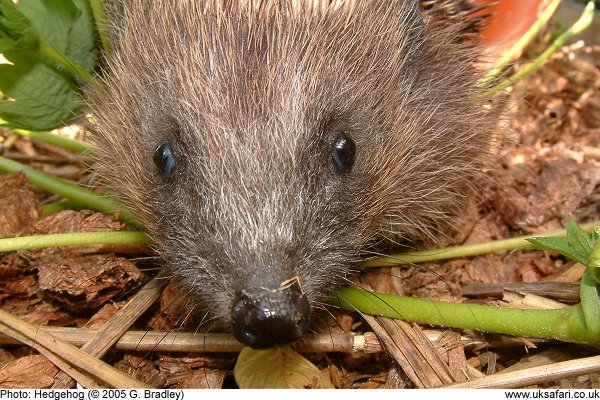 Hedgehogs
HedgehogsIdentify It > Mammal Section > Hedgehogs >

Scientific name: Erinaceus europaeus
Size: Hedgehogs grow to around 25cm from nose to tail, and have a bulky body weighing around 1kg. The tail is between 2 and 3cm long
Distribution: Found throughout the U.K. but declining in number
Months seen: April to October. Hedgehogs hibernate for the remainder of the year
Habitat: Hedgerows, grassland and gardens
Food: Beetles, slugs, snails and other invertebrates
Special features: Hedgehogs are different from every other UK mammal in that they have a coat of around 6,000 spines on their back. Hedgehog spines are essentially just extra thick, pointed hairs. Although the spines are sharp, and a good defence against predators, they are not barbed like the spines on a porcupine.
Hedgehogs do their hunting at night. They have a strong sense of smell and hearing, but relatively poor eyesight. They're great to have in the garden, since they eat many of the creatures which gardeners regard as pests. They get their name from the pig-like snorting noise they make while snuffling through hedgerows. The males are called boars and the females are called sows.
Hedgehogs can swim, and they can climb almost vertical walls. They can also run at speeds of up to two metres per second.
They reach sexual maturity in their second year. After emerging from their first winter in hibernation they build up their body weight, and by late April they are ready to breed. The ideal mating time would be on a warm night, usually between May and June.
Mating begins when the male finds a female on his nightly hunting trip. As he approaches her, he makes lots of pig-like snorting noises, and then he shuffles round and round her, trying to gain her attention. This can sometimes go on for hours, as the female is usually more interested in foraging for food than mating. All the male can do is snort louder, and circle closer to her.
If he is persistent enough, the female may give in and allow the male to mate with her. Mating only lasts for a minute or two, but the female must completely flatten her back before the male can mount her, otherwise he could be seriously injured on her spines. After the two separate, the male plays no further part in bringing up the family. If the mating is successful, the babies are born four weeks later.
Hedgehogs generally have two litters each year of between five and seven young. The female makes a nest just underground of dry leaves and grass. In gardens they often choose to nest under sheds. Fortunately for the mother, the hoglets are born without spines, but are covered with short white hairs which gradually turn into spines.
After one month the young are ready to leave the nest on foraging trips with their mother. After two months they are ready to leave their mother who will then start another brood.
In order to protect themselves from predators, hedgehogs have a row of muscles along the underside of their bodies which allow them to roll up into a tight ball of prickles. Unfortunately this is no defense against the motor car, and thousands of hedgehogs are killed on UK roads every year.
Hedgehogs hibernate in the UK between October and April, when the weather is cold. The hibernation site is often under leaves or logs where they can be sheltered from the worst of the weather. Always check piles of garden waste before starting a bonfire as there may be a hedgehog in there!
There can be up to 500 fleas on one hedgehog, but the fleas are a specific type which have adapted to life amongst the tough hedgehog spines. Although they sometimes get passed to dogs, cats and humans, they rarely bite. When they do, they usually drop off and go looking for another hedgehog.
 Related Pages
Related Pages

 Popular Pages
Popular PagesAmphibians, Bats, Badgers, Beetles, Birds, Birds of Prey, Bumble Bees, Butterflies, Caterpillars, Climate Change, Deadly Spiders, False Widow Spiders, Frogs, Funny, Garden Spiders, Glow-Worms, Hedgehogs, House Spiders, Owls, Spiders, Toads, What's Out Now?
Copyright © 2024 G. Bradley UK Safari. All rights reserved | About Us | Links | Advertise | Contributors